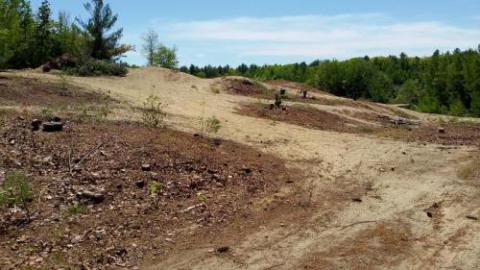Sand & Gravel Pits: Are we overlooking a solution to a critical habitat need?

Vegetation was removed to provide turtle nesting habitat from an unreclaimed sand and gravel pit site located in southern New Hampshire. [Melissa Doperalski, NHFG]
Sand and gravel pits are numerous and widespread throughout New Hampshire, making up about 0.35% of New Hampshire’s landscape. Often overlooked and left unreclaimed, or quickly turned over into industrial or commercial development; these landscapes are rarely as barren as they appear to be and can provide important and critical habitat for a variety of species. Many of these species are considered species of greatest conservation need and some are state-listed threatened or endangered species that require open habitats that are not plentiful in New Hampshire’s largely forested and growing human-developed landscape.
Natural resource agencies are teaming together to encourage and create forest openings and early successional habitat with public and private landowners. Coming up with creative ways to work with the activities that impact forested habitats, such as leaving log landings unseeded in select areas to provide turtle nesting habitat, so that they can result in providing benefits to species that require more open habitats for all or part of their life history. Sand and gravel pits are a largely untapped existing or newly developed open landscape feature that can be utilized to improve or maintain biological diversity through proper management and protection. An article published in The Wildlife Professional (Jan/Feb 2018), Managing Reclaimed Sand and Gravel Mines, explores how these areas can contribute to sensitive wildlife habitat needs in New Hampshire.
Melissa Doperalski, NH Fish & Game
Fall 2018 Taking Action for Wildlife Newsletter


